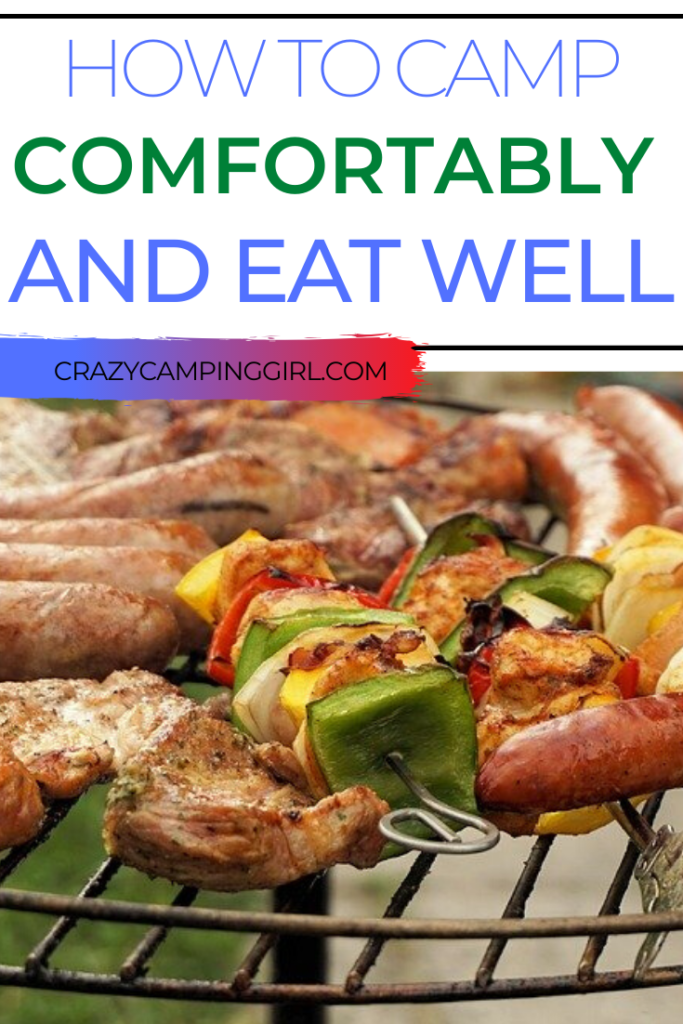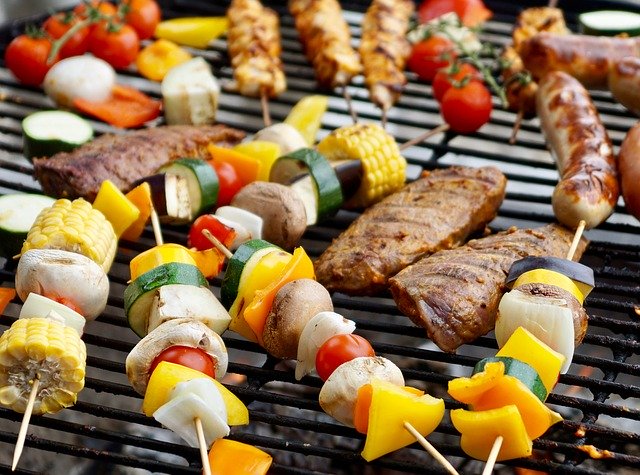
How to Camp Comfortably and Eat Well Outdoors
We may earn money or products from the companies mentioned in this post.
Whether it’s unloaded from a coolbox in a car or carried in a backpack for days, camping food still needs to be good food. The equipment available when camping determines what kind of food can be prepared, but need not determine its quality.

It is possible to camp at locations that give access to self-catering kitchens, but many people enjoy the fun of cooking in the open air. Here are some suggestions for ways to use different facilities to make fantastic food outdoors.
How to Camp Comfortably and Eat Well
These are all things to think of when looking at how to camp comfortably.
Cool and Convenient Car Camping
One of the great advantages of staying at a campsite accessible by car is the ability to refrigerate food using a good coolbox or cooler. This allows for more meat on the menu, and luxuries like milk to go in the morning coffee.
The other benefit of not having to carry the kitchen too far is a wide range of equipment to use. Breakfast might be best cooked on a two-burner gas camping stove, while supper gives a chance to barbeque.
If camping without a coolbox, meat should be left off the menu after the first few days. To extend its life past the first few hours, try pre-cooking then freezing meat in a sauce. This works particularly well for fajita fillings, with onions and peppers already mixed in to save on prep time and dishes on site.
Another effective solution for the end of a long car drive is a marinade, especially an alcoholic one with some naturally preservative properties. Try mixing rum or whiskey with soy sauce and season it with garlic or ginger. Vegetarian options like halloumi cheese or portobello mushrooms can add flair to a salad or barbecue after the second day.
Bring Your Own Grill
Disposable grills are a great tool when camping, giving the next best thing to an open campfire without the inherent likelihood of burning half the meal. Sold in a variety of sizes to suit the number of diners, they come ready to light and are perfect if you are looking at how to camp comfortably.
Any favorite BBQ recipes will work well on these. Try marinated steaks or pork chops, roasted vegetables on skewers and foil-wrapped garlic bread for a truly gourmet meal, or the more traditional burgers and sausages for an authentic trip down memory lane.
The key to cooking well on a grill is to plan cooking times carefully. No one wants burnt meat and raw onions on the same kebab stick. One tip is to cook items with similar cooking times together – serve two vegetable kebabs rather than one, one with peppers and onions that take a bit longer to prepare, the other with cherry tomatoes, mushrooms, and halloumi cheese that will warm through faster.

Another great way to enjoy barbeques is to treat them like an open fire after the meal. Liftoff the grill grate and stir up the coals to give a hotbed of coals over which marshmallows will merrily roast. Make S’Mores by spreading biscuits or graham crackers with Nutella and sandwiching roasted marshmallows between two. Chocolate-covered digestive biscuits save even more prep time – just pop a marshmallow between two graham crackers and enjoy!
Lightweight Meals That Satisfy
More menu planning is required for food that will have to be carried any real distance, or last for a longer period out of the fridge. Canoeing and hiking trips are hard work and are guaranteed to build up an appetite. Rice and pasta are both satisfying and easy to carry and can be made delicious with fairly simple sauces.
A can each of tuna, and condensed mushroom soup on pasta makes a rich and creamy treat, or a tin of tomatoes and a stock cube can make rice into a simple risotto. Many camping and outdoor shops now sell dehydrated meals that allow for even more variety, though these come at a price. To keep costs down, look for similar products such as Beanfeast, a dehydrated spaghetti bolognese sauce that is available at most food shops.
Flavored kinds of rice are also widely available. To keep up energy levels and stay well-nourished, don’t neglect vegetables either. Many prepared sauces will have some dehydrated ones already mixed in, but don’t underestimate the appeal of a fresh onion (which will keep for days at the bottom of a rucksack) fried in with almost any evening meal.
Breakfasts are equally important on a physically demanding trip and are sometimes seen as harder to keep interesting. Indeed, eggs and bacon won’t travel well unless you want the eggs ready-scrambled, but oatmeal starts to pale after the third morning unless it is kept alive by exciting toppings.
Try coconut flakes, raisins, or brown sugar to dress it up each day. A slower alternative for a morning meal that is well worth the effort is pancakes, which can be made up of a mix ahead of time with milk powder.
These can be made up of the previously mentioned ready-scrambled eggs (don’t bother carrying the shell: just crack eggs into a watertight container and use within a few days) or with a tablespoon of apricot jam in place of each egg.

The key of how to camp comfortably is to stay creative, try different things, and keep experimenting. Almost anything can be bought in a tin: just be sure to pack a can opener.
Other camping food posts you may enjoy:
- 40 Great Hobo Packets for Camping
- Outdoor Gourmet Vegetarian Camping Food and Recipe Ideas
- The Benefits of Car Camping For Your Budget
- How do You Keep Your Food Cold When Camping Without a Fridge?
- What Should Be In Every Camper’s Cooler
